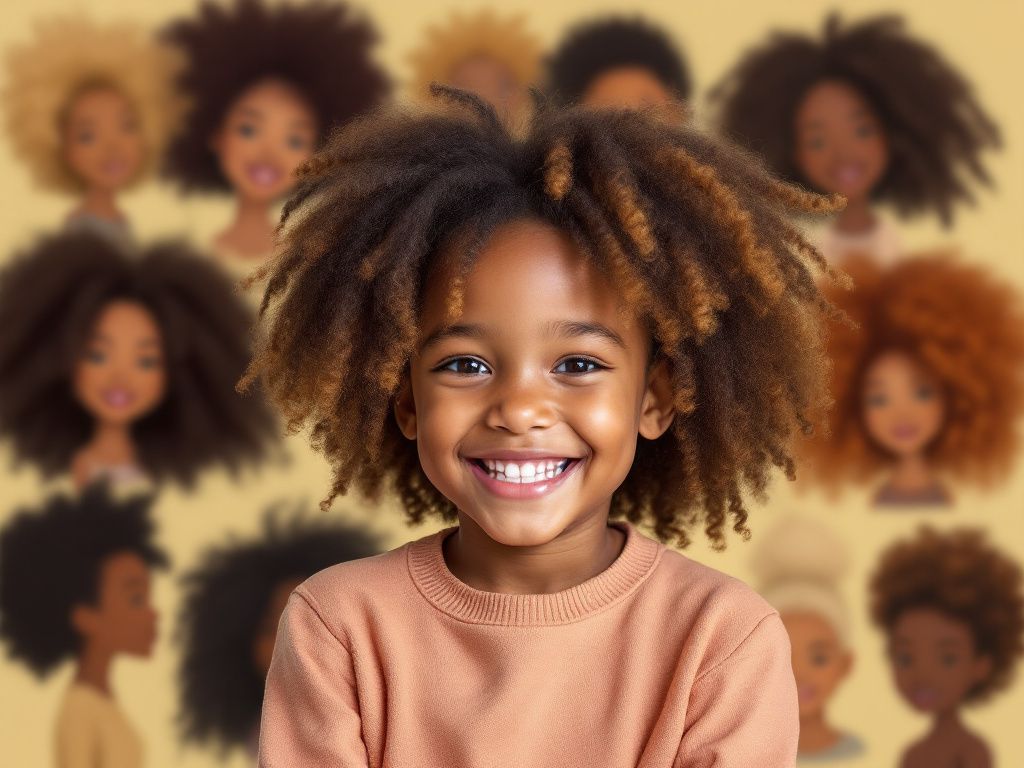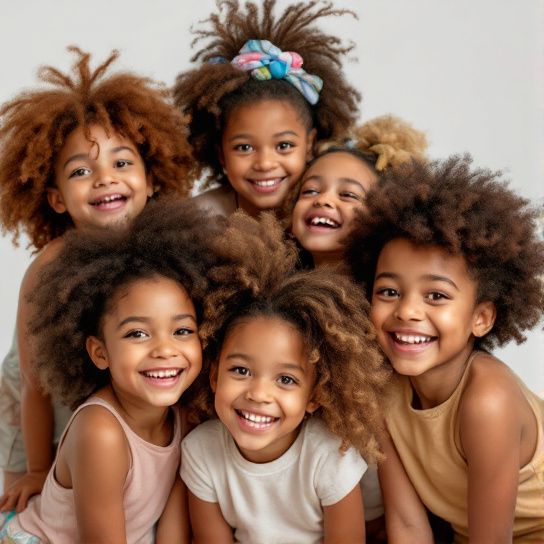
Ever wonder how to ensure the children in your life grow up embracing their unique natural hair? You’re in the right place. As an expert in family dynamics and with a deep commitment to promoting self-love and acceptance, I’ve created this comprehensive guide to help you become an effective partner in nurturing your child’s hair acceptance.
Natural hair love isn’t just a trend; it’s a fundamental shift towards embracing one’s identity and celebrating diversity. When kids learn to love their natural hair, they’re not just accepting their appearance — they’re also affirming their worth and uniqueness. This comprehensive guide will arm you with everything you need to know about teaching children to see the beauty in their texture, creating an ongoing legacy of self-love and confidence.
Understanding Family Hair Dynamics
Family Hair Dynamics: A Foundation for Understanding
In any household, discussing physical traits passed down through genetics opens a light-hearted yet pivotal discourse on acceptance and identity. Hair texture is an integral part of this conversation and often reflects a complex blend of family’s heritage, involving more than mere biology. According to a Stanford University study, children as young as three pick up on societal cues relating to physical traits, including hair. Therefore, early engagement with positive messages about hair diversity applies as both acceptance and self-discovery practice.
Embracing Texture Diversity: The Core of Hair Love
Why Texture Awareness Matters
Texture awareness isn’t only about understanding the curls, strands, or waves; it involves an appreciation for diversity and individuality. By acknowledging the varied textures present within a family setting, you facilitate more comprehensive connectivity and acceptance. The Natural Hair Institute’s 2020 report emphasized the psychological benefits linked to acceptance of one’s natural hair. Children who are taught to appreciate texture diversity show higher self-esteem levels compared to their counterparts who don’t encounter positive reinforcement about their appearance.
Strategic Teaching of Texture Love
- Early Exposure:
- Introduce books and stories that feature a wide array of characters with different hair textures. “Hair Love” by Matthew A. Cherry is an excellent resource, offering children relatable narratives about navigating hair differences in a supportive environment.
- Use of Technology:
- With the increasing availability of educational videos and interactive apps exploring diversity in physical appearance, leverage these tools for engaging storytelling moments. They can help explain that all hair textures are beautiful and equally valuable.
- Hands-On Exploration:
- Organize playdates or workshops where children can learn together while experimenting with hairstyles typical in various cultures. This can be a fun, positive way for friends and siblings to engage with different hair textures and bonding over shared experiences.
Partnering in Hair Acceptance

Breaking Down Stereotypes with Hair Education
Hair education begins at home and continues into schools and broader communities. By teaching children to accept varied textures through informed and sensitive guidance, you can counter prevalent stereotypes about hair types effectively. According to the Journal of Social Psychology, children develop stereotypes based on socialization, including media influences by age 7, hence our role in counterpressing these influences before they solidify.
**Actionable Steps for Stereotype Breakage**:
- Representation Matters: Provide access to dolls, action figures, and media that represent a broad spectrum of textures and hairstyles to normalize appearance diversity.
- Celebration of Differences: Encourage diversity days where children are celebrated for their unique styles, fostering a sense of pride and collective inclusivity.
The Role of Social Learning in Partnering Hair Acceptance
Children learn a lot through imitation and observation. Parents, caregivers, and teachers serve as their models for understanding beauty standards and acceptance.
Modelling Positive Attitude
When adults consistently demonstrate positive attitudes towards their own hair and the hair of others, children are more likely to develop similar attitudes. A survey by Dove in 2016 on hair confidence showed that adults who engaged in nurturing hair interventions with positivity had children twice as likely to embrace their natural hair by age 10.
Countering Negative Narratives
Combating negative societal narratives requires continuous dialogue and correcting misconceptions. Use incidences of hair debates in popular media as teachable moments to express that all textures—be they coily, curly, wavy, or straight—hold their distinct, inherent beauty.

Practical Steps for Building Confidence in Natural Hair
Crafting Meaningful Hair Rituals
Creating daily or weekly routine where children participate in hair grooming can instill both self-reliance and pride.
- Participate in Grooming Sessions:
- Whether it’s applying gentle shampoo techniques, detangling routines, or styling, make it a co-activity. Product manufacturers such as Shea Moisture provide children-friendly products that make this bonding time both enjoyable and educational.
- Teach Hair Science:
- Explain the biology of hair texture gently. Discuss elements like moisture retention, porosity, and elasticity in a fun, digestible manner, possibly integrating playful experiments that adults and children can enjoy together using safe, kitchen-based ingredients like oils and conditioners found at home 😃.
Importance of Hair-related Affirmation
Empowering dialogue reinforces a child’s understanding and embracing of their hair. According to studies presented in Pediatric Healthcare Reports, continuous affirmation leads to more resilient psychological frameworks in kids. Incorporate daily affirmations focusing on ‘loving my curls’ or ‘my hair is beautiful as it is’ into routines.
Leveraging Community Support
Engage with Community Resources
Immerse in culturally enriching programs such as local hair love workshops, summer camps, or hair-styling classes designed for children. These initiatives often offer first-hand engagement through various multi-texture discourse and activities, broadening a child’s perspective.
- Community Panels & Seminars:
- Attend or participate in forums discussing hair acceptance in schools or community centers.
- Hair Festivals & Parades:
- Encourage participation in events showcasing cultural stories and representation, nurturing self-proclamation beyond hyperlocal environments.
School-Based Programs Enhancing Hair Acceptance

Form networks with other parents and advocate for inclusivity-based modules within schools. Many school curriculums now side projects that enhance awareness and appreciation for natural hair textures. You can initiate partnerships through Parent-Teacher Associations to enhance these programs.
Partnering with Industry Standards
Engage with initiatives like “The Crown Act,” which seek to eradicate hair discrimination legally across workplaces and schools. Supporting such causes provides visionary standards for the next generation on diversity and equal opportunity.
Technical Considerations and Expert Analysis
Understanding technicalities in hair care can fortify the approaches adopted towards hair texture respect and love within families.
Key Considerations
- Use of pH-balanced products: Kids’ hair tends to be more sensitive; thus, utilizing products that maintain hair and scalp pH highly is advisable, as recommended by dermatologists featured in Pediatric Dermatology.
- Sensitive Styling: Limit excessive use of heat and chemical styling to protect young hair follicles, advocating for growth-friendly and texture-preserving approaches.
Expert Insight
Dermatologists and hair specialists consistently note the correlation between early acceptance and lessened incidences of hair-shame-related anxiety. Modern parenting applies holistic practices not troubleshooting individual bias; hence giving deliberate space for acceptance evolution promotes a wealthier self-love journey.
Conclusion
This guide presents tools and strategies aimed at enriching the appreciation of natural hair from an early age. By encountering supportive family hair dynamics, we’d help children to register beauty through their individually intriguing strands and curls. Always relishing this manipulation-free incarnation encourages able futuristic adults enriched with strength, self-comfort, and genuine respect for varied poplin. Consistently construct an environment that stands as a receptive field for continuous learning and progress of one’s natural traits.
Spread the texture love ❤️! Forever stipple these seeds of effortful growth and acclaiming relationships into a rise for a deeply treasured next juncture in time.
Frequently Asked Questions
What are the benefits of using a hair mask in my hair care routine?
Using a hair mask can provide several benefits, including hydration, smoothing, strengthening, curl definition, heat protection, and damage repair. Hair masks infuse the hair with moisture, help coat the hair shaft to seal split ends, reduce breakage, and protect the hair from heat styling and environmental damage[1][4].
What ingredients should I look for in a hair mask?
Effective hair masks often include ingredients such as coconut oil, argan oil, shea butter, honey, avocado oil, green tea, and coconut water. These ingredients provide nourishment, moisturize, and protect the hair, offering benefits like softening, moisturizing, and protecting against damage[2][5].
How often should I use a hair mask in my routine?
You should use a hair mask whenever your hair feels dry, unmanageable, or in need of intense hydration. This can vary depending on your hair type and needs, but generally, using a hair mask once or twice a week can help maintain healthy and moisturized hair[1][4].
How do I apply a hair mask for the best results?
To apply a hair mask effectively, shampoo your hair first, then apply the mask, focusing especially on the ends where hair tends to be the most damaged. Leave the mask on for anywhere from 10 minutes to overnight, depending on the type of mask and your hair’s needs[1][4].
References


Leave a Reply